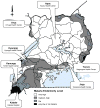Acute HIV-1 infection is highly prevalent in Ugandan adults with suspected malaria
- PMID: 20543656
- PMCID: PMC2909782
- DOI: 10.1097/QAD.0b013e32833bb732
Acute HIV-1 infection is highly prevalent in Ugandan adults with suspected malaria
Abstract
Objectives: Acute febrile illnesses consistent with malaria are the most common presentation at health clinics in sub-Saharan Africa, accounting for 30-50% of outpatient visits. The symptoms of acute HIV infection can mimic acute malaria. We investigated whether acute HIV infections could be identified among adults with suspected malaria at rural health centers in Uganda.
Design: A cross-sectional study of 1000 consecutive patients referred for malaria blood smears at each of seven government health centers, of which 2893 (41%) were 13 years or older and tested for HIV.
Methods: HIV enzyme immunoassay antibody testing was performed on dried blood spots and confirmed by western blot. Enzyme immunoassay-nonreactive and enzyme immunoassay-reactive, western blot-unconfirmed samples were pooled (10/pool) and tested for HIV RNA by nucleic acid amplification testing. We defined acute HIV infection as HIV-1 RNA positive with a negative or indeterminate HIV-1 western blot pattern and early HIV infection as HIV-1 RNA positive with a positive western blot pattern, but with a BED-corrected optical density of below 0.8.
Results: Of 2893 patients evaluated, 324 (11%) had test results indicating HIV infection. Overall, 30 patients (1.0%) had acute HIV infection, 56 (1.8%) had early HIV infection, and 238 (8%) had established HIV infection. Acute HIV infections were more prevalent at sites with higher HIV prevalence and lower malaria endemicity.
Conclusion: At multiple sites in Uganda, 1-3% of adults with suspected malaria had acute or early HIV infection. These findings highlight a major opportunity for expanding recognition of acute and early HIV infection in Africa.
Conflict of interest statement
Conflicts of Interest: C. Nugent is employed by Gen-Probe Incorporated and C. Bentsen is employed by Bio-Rad.
Figures
Similar articles
-
HIV-1 infection in patients referred for malaria blood smears at government health clinics in Uganda.J Acquir Immune Defic Syndr. 2007 Dec 15;46(5):624-30. doi: 10.1097/QAI.0b013e31815b2dc5. J Acquir Immune Defic Syndr. 2007. PMID: 18043317
-
Effects of malaria infection in human immunodeficiency virus type 1-infected Ugandan children.Pediatr Infect Dis J. 1997 Sep;16(9):876-81. doi: 10.1097/00006454-199709000-00011. Pediatr Infect Dis J. 1997. PMID: 9306483 Clinical Trial.
-
Evaluation of HIV infection in febrile patients visiting health centers in Lagos, Nigeria.BMC Res Notes. 2022 Feb 19;15(1):71. doi: 10.1186/s13104-022-05961-0. BMC Res Notes. 2022. PMID: 35183247 Free PMC article.
-
Epidemiology of malaria among HIV/AIDS patients in sub-Saharan Africa: A systematic review and meta-analysis of observational studies.Acta Trop. 2021 Mar;215:105798. doi: 10.1016/j.actatropica.2020.105798. Epub 2020 Dec 17. Acta Trop. 2021. PMID: 33340524
-
Folic acid supplementation and malaria susceptibility and severity among people taking antifolate antimalarial drugs in endemic areas.Cochrane Database Syst Rev. 2022 Feb 1;2(2022):CD014217. doi: 10.1002/14651858.CD014217. Cochrane Database Syst Rev. 2022. PMID: 36321557 Free PMC article.
Cited by
-
Plasmodium falciparum Infection Does Not Affect Human Immunodeficiency Virus Viral Load in Coinfected Rwandan Adults.Open Forum Infect Dis. 2014 Aug 21;1(2):ofu066. doi: 10.1093/ofid/ofu066. eCollection 2014 Sep. Open Forum Infect Dis. 2014. PMID: 25734136 Free PMC article.
-
Recent HIV-1 infection: identification of individuals with high viral load setpoint in a voluntary counselling and testing centre in rural Mozambique.PLoS One. 2012;7(2):e31859. doi: 10.1371/journal.pone.0031859. Epub 2012 Feb 21. PLoS One. 2012. PMID: 22363755 Free PMC article.
-
HIV infection in Eastern and Southern Africa: Highest burden, largest challenges, greatest potential.South Afr J HIV Med. 2021 May 28;22(1):1237. doi: 10.4102/sajhivmed.v22i1.1237. eCollection 2021. South Afr J HIV Med. 2021. PMID: 34192070 Free PMC article.
-
Incorporating Acute HIV Screening into Routine HIV Testing at Sexually Transmitted Infection Clinics, and HIV Testing and Counseling Centers in Lilongwe, Malawi.J Acquir Immune Defic Syndr. 2016 Mar 1;71(3):272-80. doi: 10.1097/QAI.0000000000000853. J Acquir Immune Defic Syndr. 2016. PMID: 26428231 Free PMC article.
-
Invasive bacterial and fungal infections among hospitalized HIV-infected and HIV-uninfected adults and adolescents in northern Tanzania.Clin Infect Dis. 2011 Feb 1;52(3):341-8. doi: 10.1093/cid/ciq103. Clin Infect Dis. 2011. PMID: 21217181 Free PMC article.
References
-
- Brenner BG, Roger M, Routy JP, et al. High rates of forward transmission events after acute/early HIV-1 infection. The Journal of infectious diseases. 2007 Apr 1;195(7):951–9. - PubMed
-
- Hollingsworth TD, Anderson RM, Fraser C. HIV-1 transmission, by stage of infection. The Journal of infectious diseases. 2008 Sep 1;198(5):687–93. - PubMed
-
- Wawer MJ, Gray RH, Sewankambo NK, et al. Rates of HIV-1 transmission per coital act, by stage of HIV-1 infection, in Rakai, Uganda. The Journal of infectious diseases. 2005 May 1;191(9):1403–9. - PubMed
Publication types
MeSH terms
Supplementary concepts
Grants and funding
LinkOut - more resources
Full Text Sources
Medical



